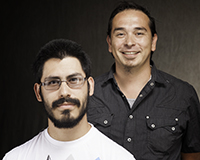
Jared Leyba and Miguel Maestas
Las Vegas, NM — Two New Mexico Highlands University computer science students presented their cutting-edge three-dimensional robotic vision system research to the Robotic and Security Systems Department at Sandia National Laboratories Aug. 27.
Las Vegas native Miguel Maestas, a computer science graduate student, developed a 3-D control sensor that determines the way in which a holographic image is manipulated for guiding mobile robots.
Jared Leyba, a computer science senior from Santa Fe, developed a 3-D stereoscopic vision system that allows the user to see what the robot is seeing.
Both students learned and used the robotic operating system (ROS), while integrating stereoscopic vision systems that plan the path for the robot in its environment. Their research will be tested on a Multifunction Utility Logistics Equipment (MULE) robot Sandia Labs loaned to Highlands in 2012.
Wendy Amai is a senior technical staff member at Sandia Labs and is part of the Robotic and Security Systems Department.
“The Highlands students did a very professional job and had us all enthralled with their presentation, which was impressive,” Amai said. “They were well prepared and it showed. Their research contributes to the technical knowledge base about using novel 3-D sensors, with applications for robotics, user interfaces, and modeling the environment.”
Computer science professor Gil Gallegos supervised Maestas and Leyba’s research and also conducted summer research at Sandia on several embedded systems to determine their computational capability. Gallegos has collaborated with Sandia on a number of robotic research projects.
“Gil is a valuable member of our research team whenever he comes to Sandia. He’s also very generous in sharing his extensive knowledge and mentoring students, whether they’re from Highlands, a high schooler, or are a post-doctoral student,” Amai said.
Gallegos said: “What’s unique about our research is that we’re developing a small, portable embedded system technology the size of a smart phone — rather than the size of a desktop system — for displaying or projecting 3-D holograms. Also, it’s rare for synthetic holography to be utilized for robotic vision systems. Holography is a technique that allows true 3-D images to be made.”
Gallegos said the system will employ low cost, off-the-shelf components.
Maestas, 36, is also the career technical adviser at Highlands for Accelerate New Mexico, a technical training and job placement program. He completed his B.S. in computational engineering at Highlands in 2009. Gallegos was his adviser then and now.
“The 3-D computer vision used for robot navigation that I worked on for this research project has important applications for my thesis research,” Maestas said. “I integrated new technology called a Leap Motion device for a stereoscopic camera into my research this summer and will refine it further for my thesis.
“It was an invaluable and exciting learning experience working with Sandia, and I feel privileged to have had the opportunity to work with Dr. Gallegos as a colleague. He’s extraordinary,” Maestas said.
Maestas helped Leyba, 25, get his paid summer internship funded through Accelerate New Mexico.
“I programmed a set of two web cameras that take two images to calculate the depth of the objects being looked at, using a point cloud — a set of 3-D data points,” Leyba said. “This stereo vision system allows the user to see what the robot is seeing.”
Gallegos said he’s very proud of Maestas and Leyba.
“This was a very complex project, and Miguel and Jared were extremely competent and productive in the work they accomplished this summer. We all worked together as a team,” Gallegos said.
He added that their research is part of an ongoing computer science and engineering project 13 of his students are conducting in synthetic holography.
“The ability to produce synthetic holograms utilizing virtual 3-D models is our goal. This involves many aspects of hardware and software development,” Gallegos said.
The research is funded through the university’s National Science Foundation Partnerships for Research and Education in Materials (PREM) grant that chemistry professor Tatiana Timofeeva secured in 2009.
